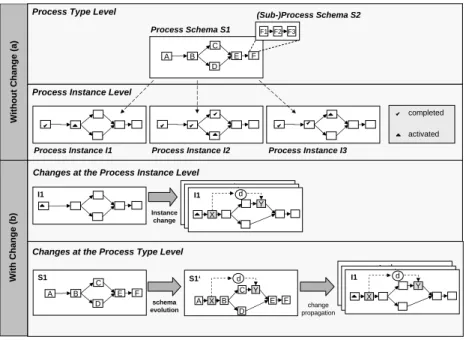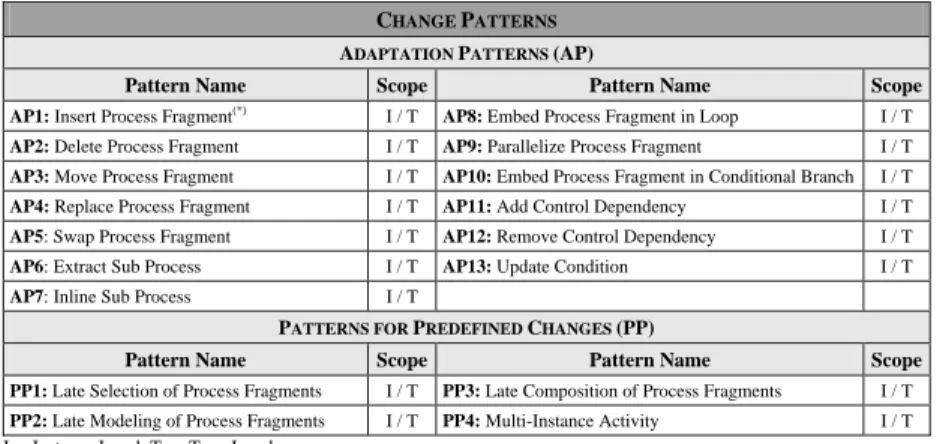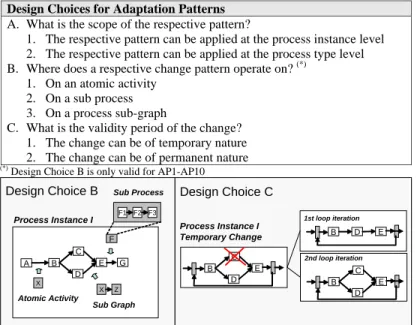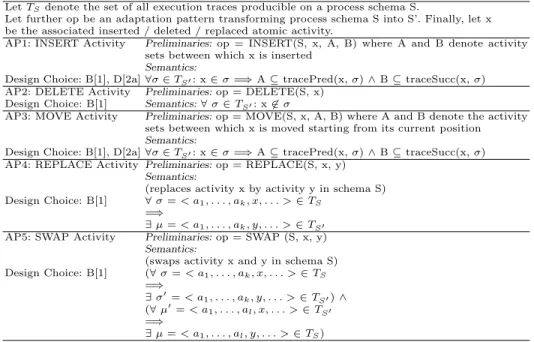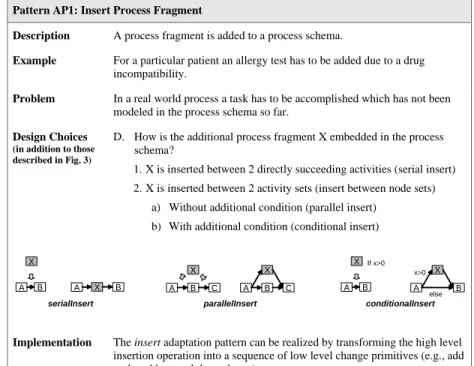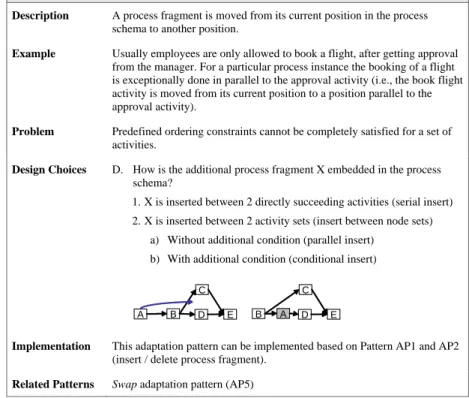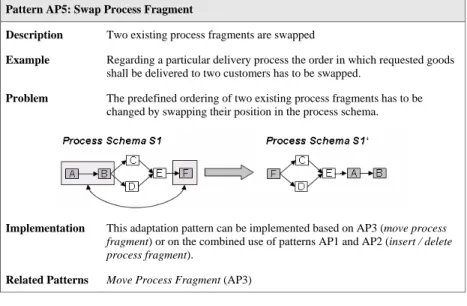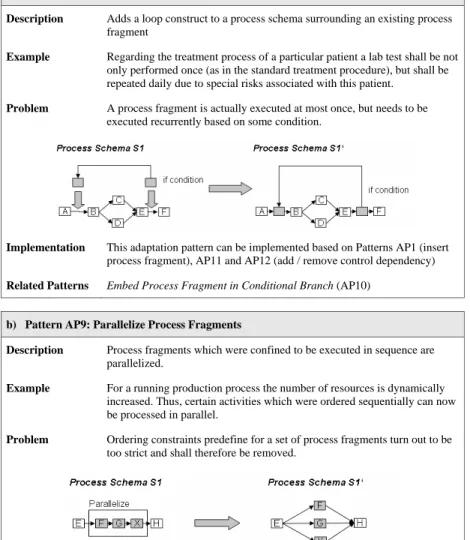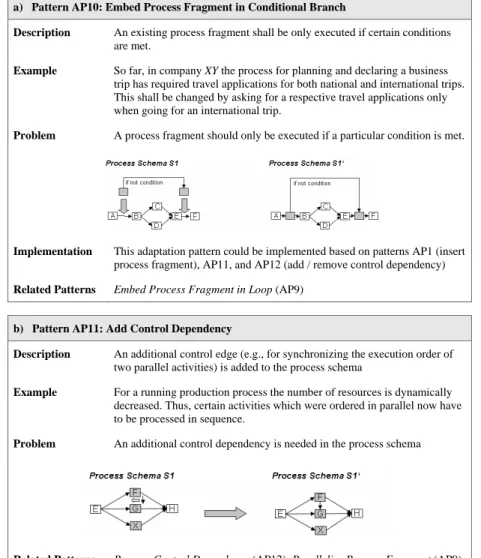Identifying and Evaluating Change Patterns and Change Support Features in
Process-Aware Information Systems
Barbara Weber1?, Stefanie Rinderle2, and Manfred Reichert3
1Quality Engineering Research Group, University of Innsbruck, Austria Barbara.Weber@uibk.ac.at
2Inst. Databases and Information Systems, Ulm University, Germany stefanie.rinderle@uni–ulm.de
3Information Systems Group, University of Twente, The Netherlands m.u.reichert@cs.utwente.nl
Abstract. In order to provide effective support, the introduction of process-aware information systems (PAIS) must not freeze existing busi- ness processes. Instead PAIS should allow authorized users to flexibly deviate from the predefined processes if required and to evolve busi- ness processes in a controlled manner over time. Many software ven- dors promise flexible system solutions for realizing such adaptive PAIS, but are often unable to cope with fundamental issues related to process change (e.g., correctness and robustness). The existence of different pro- cess support paradigms and the lack of methods for comparing existing change approaches makes it difficult for PAIS engineers to choose the adequate technology. In this paper we suggest a set of changes patterns and change support features to foster systematic comparison of existing process management technology with respect to change support. Based on these change patterns and features, we provide a detailed analysis and evaluation of selected systems from both academia and industry.
1 Introduction
Contemporary information systems (IS) more and more have to be aligned in a process-oriented way. This new generation of IS is often referred to as Process- Aware IS (PAIS) [1]. In order to provide effective process support, PAIS should capture real-world processes adequately, i.e., there should be no mismatch be- tween the computerized processes and those in reality. In order to achieve this, the introduction of PAIS must not lead to rigidity and freeze existing business processes. Instead PAIS should allow authorized users to flexibly deviate from the predefined processes as required (e.g., to deal with exceptions) and to evolve PAIS implementations over time (e.g., due to process optimizations or legal changes). Such process changes should be enabled at a high level of abstraction and without affecting the robustness of the PAIS [2].
?This work was done during a postdoctoral fellowship at the University of Twente.
The increasing demand for process change support poses new challenges for IS engineers and requires the use of change enabling technologies. Contemporary PAIS, in combination with service-oriented computing, offer promising perspec- tives in this context. Many vendors promise flexible software solutions for realiz- ing adaptive PAIS, but are often unable to cope with fundamental issues related to process change (e.g., correctness and robustness). This problem is further ag- gravated by the fact that several competing process support paradigms exist, all trying to tackle the need for more process flexibility (e.g., adaptive processes [3–5] or case handling [6]). Furthermore, there exists no method for systemat- ically comparing the change frameworks provided by existing process-support technologies. This, in turn, makes it difficult for PAIS engineers to assess the maturity and change capabilities of those technologies. Consequently, this often leads to wrong decisions and misinvestments.
During the last years we have studied processes from different application domains and elaborated the flexibility and change support features of numerous tools and approaches. Based on these experiences, in this paper we suggest a set of changes patterns and change support features to foster the comparison of existing approaches with respect to process change support. Change patterns allow for high-level process adaptations at the process type as well as the process instance level. Change support features ensure that changes are performed in a correct and consistent way, traceability is provided, and changes are facilitated for users. Both change patterns and change support features are fundamental to make changes applicable in practice. Finally, another contribution of this paper is the evaluation of selected approaches/systems based on the presented change patterns and change support features.
Section 2 summarizes background information needed for the understanding of this paper. Section 3 describes 17 change patterns and Section 4 deals with 6 crucial change support features. Based on this, Section 5 evaluates different approaches from both academia and industry. Section 6 discusses related work and Section 7 concludes with a summary.
2 Backgrounds
A PAIS is a specific type of information system which allows for the separation of process logic and application code. At run-time the PAIS orchestrates the processes according to their defined logic. Workflow Management Systems (e.g., Staffware [1], ADEPT [3], WASA [5]) and Case-Handling Systems (e.g., Flower [1, 6]) are typical technologies enabling PAIS.
For each business process to be supported a process type represented by a process schemaS has to be defined. In the following, a process schema is repre- sented by a directed graph, which defines a set of activities– the process steps – and control connections between them (i.e., the precedence relations between these activities). Activities can either be atomic or contain a sub process (i.e., a reference to a process schema S0) allowing for the hierarchical decomposition of a process schema. In Fig. 1a, for example, process schemaS1 consists of six
activities: ActivityA is followed by activityB in the flow of control, whereasC and D can be processed in parallel. Activities A to E are atomic, and activity F constitutes a sub process with own process schema S2. Based on a process schema S, at run-time newprocess instances I1, . . . , In can be created and ex- ecuted. Regarding process instance I1 from Fig. 1a, for example, activity A is completed and activityBis activated (i.e., offered in user worklists). Generally, a large number of process instances might run on a particular process schema.
PAIS must be able to cope with change. In general, changes can be triggered and performed at two levels – the process type and the process instance level (cf. Fig. 1b) [2]. Schema changes at the type level become necessary to deal with the evolving nature of real-world processes (e.g., to adapt to legal changes). Ad- hoc changes of single instances are usually performed to deal with exceptions, resulting in an adaptedinstance-specificprocess schema.
A B C D
E F
Process Type Level
Process Schema S1 F1 F2 F3
Process Instance Level
Process Instance I1 Process Instance I2 Process Instance I3 (Sub-)Process Schema S2
Changes at the Process Instance Level
X Y I5 d
X Y I4 d
X Y I1 d
A B C D
E F
Changes at the Process Type Level
S1‘
B A
D E F X
Y d
C X
Y I5 d
X Y I4 d
X Y I1 d
change propagation schema
evolution S1
I1
Instance change
Without Change (a)With Change (b)
completed activated
Fig. 1.Core Concepts
3 Change Patterns
In this section we describe 17 characteristic patterns we identified as relevant forcontrol flow changes(cf. Fig. 2). Adaptations of other process aspects (e.g., data or resources) are outside the scope of this paper. Change patterns reduce the complexity of process change (like design patterns in software engineering reduce system complexity [7]) and raise the level for expressing changes by pro- viding abstractions which are above the level of single node and edge operations.
Consequently, due to their lack of abstraction, low level change primitives (add
node, delete edge, etc.) are not considered to be change patterns and thus are not covered in this section.
As illustrated in Fig. 2, we divide our change patterns intoadaptation pat- ternsandpatterns for predefined changes. Adaptation patterns allow modifying the schema of a process type (type level) or a process instance (instance level) using high-level change operations. Generally, adaptation patterns can be ap- plied to the whole process schema or process instance schema respectively; they do not have to be pre-planned, i.e., the region to which the adaptation pattern is applied can be chosen dynamically. By contrast, for predefined changes, at build-time, the process engineer defines regions in the process schema where potential changes may be performed during run-time.
For each pattern we provide a name, a brief description, an illustrating exam- ple, a description of the problem it addresses, a couple of design choices, remarks regarding its implementation, and a reference to related patterns.Design Choices allow for parameterization of patterns keeping the number of distinct patterns manageable. Design choices which are not only relevant for particular patterns, but for a whole pattern category, are described only once at the category level.
Typically, existing approaches only support a subset of the design choices in the context of a particular pattern. We denote the combination of design choices supported by a particular approach as apattern variant.
CHANGE PATTERNS ADAPTATION PATTERNS (AP)
Pattern Name Scope Pattern Name Scope
AP1: Insert Process Fragment(*) I / T AP8: Embed Process Fragment in Loop I / T AP2: Delete Process Fragment I / T AP9: Parallelize Process Fragment I / T AP3: Move Process Fragment I / T AP10: Embed Process Fragment in Conditional Branch I / T AP4: Replace Process Fragment I / T AP11: Add Control Dependency I / T AP5: Swap Process Fragment I / T AP12: Remove Control Dependency I / T AP6: Extract Sub Process I / T AP13: Update Condition I / T AP7: Inline Sub Process I / T
PATTERNS FOR PREDEFINED CHANGES (PP)
Pattern Name Scope Pattern Name Scope
PP1: Late Selection of Process Fragments I / T PP3: Late Composition of Process Fragments I / T PP2: Late Modeling of Process Fragments I / T PP4: Multi-Instance Activity I / T I… Instance Level, T … Type Level
(*) A process fragment can either be an atomic activity, an encapsulated sub process or a process (sub) graph
Fig. 2.Change Patterns Overview
3.1 Adaptation Patterns
Adaptation patterns allow to structurally change process schemes. Examples include the insertion, deletion and re-ordering of activities (cf. Fig. 2). Fig. 3 describes general design choices valid for all adaptation patterns. First, each adaptation pattern can be applied at the process type or process instance level (cf. Fig. 1b). Second, adaptation patterns can operate on an atomic activity, an encapsulated sub process or a process (sub-)graph (cf. Fig. 3). We abstract from
this distinction and use the generic concept process fragment instead. Third, the effects resulting from the use of an adaptation pattern at the instance level can be permanent or temporary. A permanent instance change remains valid until completion of the instance (unless it is undone by a user). By contrast, a temporary instance change is only valid for a certain period of time (e.g., one loop iteration) (cf. Fig. 3).
Design Choices for Adaptation Patterns A. What is the scope of the respective pattern?
1. The respective pattern can be applied at the process instance level 2. The respective pattern can be applied at the process type level B. Where does a respective change pattern operate on? (*)
1. On an atomic activity 2. On a sub process 3. On a process sub-graph
C. What is the validity period of the change?
1. The change can be of temporary nature 2. The change can be of permanent nature
(*) Design Choice B is only valid for AP1-AP10
Process Instance I Temporary Change
B C D
E
B D E
B C D
E 1st loop iteration
2nd loop iteration B
A
C D
E F Process Instance I F1 F2 F3
Sub Process
G
X Z X
Atomic Activity
Sub Graph
Design Choice B Design Choice C
Fig. 3.Design Choices for Adaptation Patterns
In the following all 13 adaptation patterns are described in detail. These 13 patterns allow for the insertion (AP1), deletion (AP2), movement (AP3), and replacement (AP4) of process fragments in a given process schema. They further allow for the swapping of activities (AP5), extraction of a sub process from a process schema (AP6), inclusion of a sub process into a process schema (AP7), embedding of an existing process fragment in a loop (AP8), parallelization of pro- cess fragments (AP9), embedding of a process fragment in a conditional branch (AP10), addition of control dependencies (AP11), removal of control dependen- cies (AP12), and update of transition conditions (AP13).
Adaptation Pattern AP1: Insert Process Fragment. TheInsert Process Fragmentpattern (cf. Fig. 5) can be used to add process fragments to a process schema. In addition to the general options described in Fig. 3, one major design choice for this pattern (Design Choice D) describes the way the new process fragment is embedded in the respective schema. There are systems which only
allow to serially insert a fragment between two directly succeeding activities.
By contrast, other systems follow a more general approach allowing the user to insert new fragments between two arbitrary sets of activities [3]. Special cases of the latter variant include the insertion of a fragment in parallel to another one or the association of the newly added fragment with an execution condition (conditional insert).
Adaptation Pattern AP2: Delete Process Fragment. The Delete Pro- cess Fragment pattern, in turn, can be used to remove a process fragment (cf.
Fig 6). No additional design choices exist for this pattern. Fig. 5b depicts alter- native ways in which this pattern can be implemented.
Adaptation Pattern AP3: Move Process Fragment. The Move Process Fragment pattern (cf. Fig. 7) allows to shift a process fragment from its cur- rent position to a new one. Like for the Insert Process Fragment pattern, an additional design choice specifies the way the fragment can be embedded in the process schema afterwards. Though theMove Process Fragmentpattern could be realized by the combined use of AP1 and AP2 (Insert/Delete Process Fragment), we introduce it as separate pattern as it provides a higher level of abstraction to users.
Adaptation Pattern AP4: Replace Process Fragment.This pattern sup- ports the replacement of a process fragment by another one (cf. Fig. 8). Like theMove Process Fragmentpattern, this pattern can be implemented based on patterns AP1 and AP2 (Insert/Delete Process Fragment).
Adaptation Pattern AP5: Swap Process Fragments. TheSwap Process Fragment pattern (cf. Fig. 9) allows to swap a process fragment with another one. This adaptation pattern can be implemented based on AP3 (Move Process Fragment)or on the combined use of patterns AP1 and AP2 (Insert/Delete Pro- cess Fragment).
Adaptation Pattern AP6: Extract Sub Process.The patternExtract Sub Process (AP6) allows to extract an existing process fragment from a process schema and to encapsulate it in a separate sub process schema (cf. Fig. 10).
This pattern can be used to add an additional hierarchical level in order to simplify a respective process schema or to hide information from process partic- ipants. If no direct support of pattern AP6 is provided a workaround could look as follows: The new process schema representing the extracted sub process has to be created manually. As a next step the respective process fragment must be copied to the new process schema and be removed from the original one. In addi- tion, an activity referencing the newly implemented sub process must be added to the original process schema. Further, required input and output parameters must be manually mapped to the sub process. In general, the implementation of pattern AP6 should be based on graph aggregation techniques.
Adaptation Pattern AP7: Inline Sub Process.As opposed to pattern AP6, the patternInline Sub Process(AP7) allows to inline a sub process schema into the parent process schema, and consequently to flatten the hierarchy of the over- all process (cf. Fig. 11). If no direct support for patterns AP7 is provided a couple of manual steps will be required as workaround. First the process fragment rep- resenting the sub process has to be copied to the parent process schema. In a next step the activity which has invoked the sub process has to be replaced by the previously copied process fragment. Further, input and output parameters of the sub process have to manually mapped to the newly added activities.
Adaptation Pattern AP8: Embed Process Fragment in Loop. Using this pattern an existing process fragment can be embedded in a loop in order to allow for a repeated execution of the respective process fragment (cf. Fig. 12a).
This patterns can be realized based on Patterns AP1 (Insert Process Fragment), AP11 and AP12 (Add / Remove Control Dependency).
Adaptation Pattern AP9: Parallelize Process Fragments.This patterns enables the parallelization of process fragments which were confined to be ex- ecuted in sequence (cf. Fig. 12b). If no direct support is provided for AP9, it can be realized by combining patterns AP11 and AP12 (Add / Remove Control Dependency).
Adaptation Pattern AP10: Embed Process Fragment in Conditional Branch. Using this pattern an existing process fragment can be embedded in a conditional branch, which consequently is only executed if certain conditions are met (cf. Fig. 13a). AP10 can be implemented based on patterns AP1 (Insert Process Fragment), AP11 and AP12 (Add / Remove Control Dependency).
Adaptation Pattern AP11: Add Control Dependency. When applying this adaptation pattern an additional control edge (e.g., for synchronizing the ex- ecution order of two parallel activities) is added to the given process schema (cf.
Fig. 13b). As opposed to the low-level change primitiveadd edge, the added con- trol dependency can be associated with attributes when applying pattern AP11.
As an example consider the use of transition conditions. Another parameteri- zation of AP11 will become necessary if different kinds of control dependencies (e.g., loop backs, synchronization of parallel activities) have to be considered.
Usually, approaches implementing AP11 also ensure that the use of this pattern meets certain pre- and post-conditions (e.g., guaranteeing the absence of cycles or deadlocks).
Adaptation Pattern AP12: Remove Control Dependency. Using this pattern a control dependency and its attributes can be removed from a process schema (cf. Fig. 14a). Similar considerations can be made as for pattern AP11.
Adaptation Pattern AP13: Update Condition.This pattern allows to up- date transition conditions in a process schema (cf. Fig. 14b). Usually, an imple- mentation of this pattern has to ensure that the new transition condition correct in the context of the given process schema (e.g., all workflow relevant data el- ements the transition condition refers to must be present in the process schema).
To put the pattern-based analysis of existing systems on a firm footing we have defined a formal semantics for adaptation patterns. The description of control flow patterns [8], for example, is based on Petri Nets. Therefore these patterns already have an inherent formal semantics. Regarding adaptation patterns, in turn, we have to find a semantical description which is independent of a particu- lar process meta model. In our context, we base this description on the behavioral semantics of the respective process schema before and after its change. One way to capture behavioral semantics is to use execution traces. For this purpose, first of all, we provide some preliminary definitions.
Definition 1 (Execution Trace).LetAbe a set of activities which can be used to specify a process schema S. Let further Q be the set of all possible execution traces over S. A trace σ ∈ Q is defined as σ = < a1, . . . , ak > where ai ∈ A, i= 1, . . . , k, and the order of ai inσreflects the order in which activitiesai are completed over S. Then:
– traceSucc(a, σ)1 denotes the function which returns all activities which have been completed after activity a according to traceσ. Formally:
traceSucc:A × Q 7→2A with
traceSucc(a,< a1, . . . , ak, a, ak+1, . . . , an>) =< ak+1, . . . , an>
– analogously tracePred(a,σ) denotes the function which returns all activities which have been completed before activity a according to traceσ.
Based on this meta-model independent notion of execution traces we exem- plarily describe the semantics of selected pattern variants in Figure 4.
3.2 Patterns for Predefined Changes
The applicability of adaptation patterns is not restricted to a particular process part a priori. By contrast, the following patterns predefine constraints concern- ing the parts that can be changed. At run-time changes are only permitted within these parts. In this category we have identified 4 patterns,Late Selection of Process Fragments (PP1), Late Modeling of Process Fragments (PP2), Late Composition of Process Fragments(PP3) andMulti-Instance Activity(PP4).
Predefined Change Pattern PP1: Late Selection of Process Fragments.
The Late Selection of Process Fragments pattern (cf. Fig. 15) allows to select the implementation for a particular process step at run-time either based on
1 Note that in this paper, for the definition of functions traceSucc and tracePred we assume that process schema S is acyclic.
LetTSdenote the set of all execution traces producible on a process schema S.
Let further op be an adaptation pattern transforming process schema S into S’. Finally, let x be the associated inserted / deleted / replaced atomic activity.
AP1: INSERT Activity Preliminaries:op = INSERT(S, x, A, B) where A and B denote activity sets between which x is inserted
Semantics:
Design Choice: B[1], D[2a]∀σ∈TS0: x∈σ=⇒A⊆tracePred(x,σ)∧B⊆traceSucc(x,σ) AP2: DELETE Activity Preliminaries:op = DELETE(S, x)
Design Choice: B[1] Semantics:∀σ∈TS0: x6∈σ
AP3: MOVE Activity Preliminaries:op = MOVE(S, x, A, B) where A and B denote the activity sets between which x is moved starting from its current position Semantics:
Design Choice: B[1], D[2a]∀σ∈TS0: x∈σ=⇒A⊆tracePred(x,σ)∧B⊆traceSucc(x,σ) AP4: REPLACE Activity Preliminaries:op = REPLACE(S, x, y)
Semantics:
(replaces activity x by activity y in schema S) Design Choice: B[1] ∀σ=< a1, . . . , ak, x, . . . >∈TS
=⇒
∃µ=< a1, . . . , ak, y, . . . >∈TS0
AP5: SWAP Activity Preliminaries:op = SWAP (S, x, y) Semantics:
(swaps activity x and y in schema S) Design Choice: B[1] (∀σ=< a1, . . . , ak, x, . . . >∈TS
=⇒
∃σ0=< a1, . . . , ak, y, . . . >∈TS0)∧ (∀µ0=< a1, . . . , al, x, . . . >∈TS0
=⇒
∃µ=< a1, . . . , al, y, . . . >∈TS)
Fig. 4.Semantics of Selected Adaptation Patterns
predefined rules or user decisions.
Predefined Change Pattern PP2: Late Modeling of Process Frag- ments. The Late Modeling of Process Fragments pattern (cf. Fig. 16) offers more freedom and allows to model selected parts of the process schema at run- time.
Predefined Change Pattern PP3: Late Composition of Process Frag- ments. Furthermore the Late Composition of Process Fragments pattern (cf.
Fig. 17) enables the on-the fly composition of process fragments (e.g., by dy- namically introducing control dependencies between a set of fragments).
Predefined Change Pattern PP4: Multi Instance Activity. In case of Multi-Instance Activities the number of instances created for a particular ac- tivity is determined at run-time (cf. Fig. 18). Multi-instance activities enable the creation of a particular process activity during run-time. The decision how many activity instances are created can be based either on knowledge available at build-time or on some run-time knowledge. We do not consider multi instances of the former kind as change pattern as their use does not lead to change. For all other types of multi-instance activities the number of instances is determined based on run-time knowledge which can or cannot be available a-priori to the
Pattern AP1: Insert Process Fragment
Description A process fragment is added to a process schema.
Example For a particular patient an allergy test has to be added due to a drug incompatibility.
Problem In a real world process a task has to be accomplished which has not been modeled in the process schema so far.
Design Choices (in addition to those described in Fig. 3)
D. How is the additional process fragment X embedded in the process schema?
1. X is inserted between 2 directly succeeding activities (serial insert) 2. X is inserted between 2 activity sets (insert between node sets)
a) Without additional condition (parallel insert) b) With additional condition (conditional insert)
X A B
serialInsert X
A B A B C
X
A B C
X
parallelInsert
A B
X
conditionalInsert x>0
else X
A B If x>0
Implementation The insert adaptation pattern can be realized by transforming the high level insertion operation into a sequence of low level change primitives (e.g., add node, add control dependency).
Fig. 5.Insert (AP1) Process Fragmentpattern
Pattern AP2: Delete Process Fragment
Description A process fragment is deleted from a process schema.
Example For a particular patient no computer tomography is performed due to the fact that he has a cardiac pacemaker (i.e., the computer tomography activity is deleted).
Problem In a real world process a task has to be skipped or deleted.
B A
C D
E F A B D E F
Implementation Several options for implementing the delete pattern exist: (1) The fragment is physically deleted (i.e., corresponding activities and control edges are removed from the process schema), (2) the fragment is replaced by one or more null activities (i.e., activities without associated activity program) or (3) the fragment is embedded in a conditional branch with condition false (i.e., the fragment remains part of the schema, but is not executed).
Fig. 6.Delete (AP2) Process Fragmentpattern
Pattern AP3: Move Process Fragment
Description A process fragment is moved from its current position in the process schema to another position.
Example Usually employees are only allowed to book a flight, after getting approval from the manager. For a particular process instance the booking of a flight is exceptionally done in parallel to the approval activity (i.e., the book flight activity is moved from its current position to a position parallel to the approval activity).
Problem Predefined ordering constraints cannot be completely satisfied for a set of activities.
Design Choices D. How is the additional process fragment X embedded in the process schema?
1. X is inserted between 2 directly succeeding activities (serial insert) 2. X is inserted between 2 activity sets (insert between node sets)
a) Without additional condition (parallel insert) b) With additional condition (conditional insert)
B A
C
D E B
C
D E
A
Implementation This adaptation pattern can be implemented based on Pattern AP1 and AP2 (insert / delete process fragment).
Related Patterns Swap adaptation pattern (AP5)
Fig. 7.Move (AP3) Process Fragmentpattern
Pattern AP4: Replace Process Fragment
Description A process fragment is replaced by another process fragment.
Example Instead of the computer tomography activity, the X-ray activity shall be performed for a particular patient.
Problem A process fragment is no longer adequate, but can be replaced by another one.
B A
C
D E A B
X
D E
X
Implementation This adaptation pattern can be implemented based on Pattern AP1 and AP2 (insert / delete process fragment).
Fig. 8.Replace (AP4) Process Fragmentpattern
Pattern AP5: Swap Process Fragment
Description Two existing process fragments are swapped
Example Regarding a particular delivery process the order in which requested goods shall be delivered to two customers has to be swapped.
Problem The predefined ordering of two existing process fragments has to be changed by swapping their position in the process schema.
Implementation This adaptation pattern can be implemented based on AP3 (move process fragment) or on the combined use of patterns AP1 and AP2 (insert / delete process fragment).
Related Patterns Move Process Fragment (AP3)
Fig. 9.Swap Process Fragment (AP5)pattern
Pattern AP6: Extract Sub Process
Description Extract a process fragment from the given process schema and replace it by a corresponding sub process.
Example A dynamically evolving engineering process has become too large. In order to reduce complexity the process owner extracts activities related to the engineering of a particular component and encapsulates them in a separate sub process.
Problem Large process schema. If a process schema becomes too large, this pattern will allow for its hierarchical (re-)structuring. This simplifies maintenance, increases comprehensibility, and fosters the reuse of process fragments.
Duplication across process schemes. A particular process fragment appears in multiple process schemes. If the respective fragment has to be changed, this change will have to be conducted repetitively for all these schemes.
This, in turn, can lead to inconsistencies. By encapsulating the fragment in one sub process, maintenance costs can be reduced.
Implementation In order to implement AP6 graph aggregation techniques can be used.
When considering data aspects as well, variables which constitute input / output for the selected process fragment have to be determined and considered as input / output for the created sub-process.
Related Patterns Inline Sub Process (AP7)
Fig. 10.Extract Sub Process (AP6)pattern
Pattern AP7: Inline Sub Process
Description A sub process to which one or more process schemes refer is dissolved.
Accompanying to this the related sub process graph is directly embedded in the parent schemes.
Example The top level of a hierarchically structured engineering process only gives a rough overview of the product development process. Therefore, the chief engineer decides to lift up the structure of selected sub processes to the top level.
Problem Too many hierarchies in a process schema: If a process schema consists of too many hierarchy levels the inline sub process pattern can be used to flatten the hierarchy.
Badly structured sub processes: If sub processes are badly structured the inline pattern can be used to embed them into one big process schema, before extracting better structured sub-processes (based on AP6).
Implementation The implementation of this pattern can be based on other adaptation patterns (e.g., AP1). When also dealing with data aspects, the data context of the sub process and its current mapping to the parent process has to be transferred to the parent process schema.
Related Patterns Extract Sub Process (AP6)
Fig. 11.Inline Sub Process (AP7)pattern
a) Pattern AP8: Embed Process Fragment in Loop
Description Adds a loop construct to a process schema surrounding an existing process fragment
Example Regarding the treatment process of a particular patient a lab test shall be not only performed once (as in the standard treatment procedure), but shall be repeated daily due to special risks associated with this patient.
Problem A process fragment is actually executed at most once, but needs to be executed recurrently based on some condition.
Implementation This adaptation pattern can be implemented based on Patterns AP1 (insert process fragment), AP11 and AP12 (add / remove control dependency)
Related Patterns Embed Process Fragment in Conditional Branch (AP10)
b) Pattern AP9: Parallelize Process Fragments
Description Process fragments which were confined to be executed in sequence are parallelized.
Example For a running production process the number of resources is dynamically increased. Thus, certain activities which were ordered sequentially can now be processed in parallel.
Problem Ordering constraints predefine for a set of process fragments turn out to be too strict and shall therefore be removed.
Implementation This adaptation pattern can be implemented based on Patterns AP11 and AP12 (add / remove control dependency)
Fig. 12.Embbed Process Fragment in Loop (AP8) and Parallelize Process Fragments (AP9)patterns
a) Pattern AP10: Embed Process Fragment in Conditional Branch
Description An existing process fragment shall be only executed if certain conditions are met.
Example So far, in company XY the process for planning and declaring a business trip has required travel applications for both national and international trips.
This shall be changed by asking for a respective travel applications only when going for an international trip.
Problem A process fragment should only be executed if a particular condition is met.
Implementation This adaptation pattern could be implemented based on patterns AP1 (insert process fragment), AP11, and AP12 (add / remove control dependency)
Related Patterns Embed Process Fragment in Loop (AP9)
b) Pattern AP11: Add Control Dependency
Description An additional control edge (e.g., for synchronizing the execution order of two parallel activities) is added to the process schema
Example For a running production process the number of resources is dynamically decreased. Thus, certain activities which were ordered in parallel now have to be processed in sequence.
Problem An additional control dependency is needed in the process schema
Related Patterns Remove Control Dependency (AP12), Parallelize Process Fragment (AP9)
Fig. 13. Embbed Process Fragment in Conditional Branch (AP10) and Add Control Dependency (AP11)patterns
a) Remove Control Dependency
Description A control edge is removed from the process schema
Example Assume that for a medical treatment procedure, usually, test A has to be finished before test B may be started. In an emergency situation, these two tests shall be performed in parallel in order to quickly treat the respective patient
Problem An existing control dependency is not needed anymore in the process schema
Related Patterns Add Control Dependency (AP11), Parallelize Process Fragments (AP9)
b) Pattern AP13: Update Condition
Description A transition condition in the process schema is updated.
Example In a loan approval process the manager will have to approve a loan if the amount is larger than 50.000 Euro. Starting from January next year only loans above 100.000 Euros have to be approved by the manager.
Problem A transition condition has to be modified as it is no longer valid.
Related Patterns Embed Process Fragment in Loop (AP8), Embed Process Fragment in Conditional Branch (AP10)
Fig. 14.Remove Control Dependency (AP12) and Update Condition (AP13)patterns
execution of the multi-instance activity. While in the former case the number of instances can be determined at some point during run-time, this is not possible for the latter case. We consider multi-instance activities as change patterns too, since their dynamic creation works like a dynamic schema expansion. A detailed description of this pattern can be found in [8].
Pattern PP1: Late Selection of Process Fragments
Description For particular activities the corresponding implementation (activity program or sub process model) can be selected during run-time. At build time only a placeholder is provided, which is substituted by a concrete implementation during run-time (cf. Fig. 6).
Example For the treatment of a particular patient one of several different sub- processes can be selected depending on the patient’s disease.
Problem There exist different implementations for an activity (including sub- processes), but for the selection of the respective implementation run-time information is required.
Design Choices A. How is the selection process done?
1. Automatically based on predefined rules 2. Manually by an authorized user
3. Semi-automatically: options are reduced by applying some predefined rules; user can select among the remaining options B. What object can be selected?
1. Atomic activity 2. Sub process
C. When does late selection take place?
1. Before the placeholder activity is enabled 2. When enabling the placeholder activity
Implementation By selecting the respective sub process or activity program, a reference to it is dynamically set and the selected sub-process or activity program is invoked.
Related Patterns Late Modeling of Process Fragments (PP2)
Fig. 15.Late Selection of Process Fragments (PP1)
Pattern PP2: Late Modeling of Fragments
Description Parts of the process schema have not been defined at build-time, but are modeled during run-time for each process instance (cf. Fig. 6). For this purpose, placeholder activities are provided, which are modeled and executed during run-time. The modeling of the placeholder activity must be completed before the modeled process fragment can be executed.
Example The exact treatment process of a particular patient is composed out of existing process fragments at run-time.
Problem Not all parts of the process schema can be completely specified at build time.
Design Choices A. What are the basic building blocks for late modeling?
1. All process fragments (including activities) from the repository can be chosen
2. A constraint-based subset of the process fragments from the repository can be chosen
3. New activities or process fragments can be defined B. What is the degree of freedom regarding late modeling?
1. Same modeling constructs and change patterns can be applied as for modeling at the process type level (*)
2. More restrictions apply for late modeling than for modeling at the process type level
C. When does late modeling take place?
1. When a new process instance is created 2. When the placeholder activity is instantiated
3. When a particular state in the process is reached (which must precede the instantiation of the placeholder activity) D. Does the modeling start from scratch?
1. Late modeling may start with an empty template
2. Late modeling may start with a predefined template which can then be adapted
Implementation After having modeled the placeholder activity with the editor, the fragment is stored in the repository and deployed. Then, the process fragment is dynamically invoked as a sub process. The assignment of the respective process fragment to the placeholder activity is done through late binding.
Related Patterns Late Selection of Process Fragments (PP1)
(*) Which of the adaptation patterns are supported within the placeholder activity is determined by the expressiveness of the modeling language.
Fig. 16.Late Modeling of Process Fragments(PP2)
Pattern PP3: Late Composition of Process Fragments
Description At build time a set of process fragments is defined out of which a concrete process instance can be composed at run time. This can be achieved by dynamically selecting fragments and adding control dependencies on the fly (cf. Fig. 6).
Example Several medical examinations can be applied for a particular patient. The exact examinations and the order in which they are performed are defined for each patient individually.
Problem There exist several variants of how process fragments can be composed. In order to reduce the number of process variants to be specified by the process engineer during build time, process instances are dynamically composed out of fragments.
Fig. 17.Late Composition of Process Fragments (PP3)
Pattern PP4: Multi Instance Activity
Description This pattern allows the creation of multi instances of a respective activity during run-time.
Example The scanning activity has to be repeated until all parcels are scanned. The number of parcels is not known at build-time.
Problem A respective activity has to be executed several times. The number of instances that have to be created are not at build-time.
Fig. 18.Multi-Instance Activity (PP4)
4 Change Support Features
So far, we have introduced a set of change patterns, which can be used to ac- complish changes at the process type and/or process instance level. However, simply counting the number of supported patterns is not sufficient to analyze how well a system can deal with process change. In addition, change support features must be considered to make change patterns useful in practice (cf. Fig.
19). Relevant change support features includeprocess schema evolutionandver- sion control, change correctness, change traceability, access control and change reuse2. As illustrated in Fig. 19 the described change support features are not equally important for both process type level and process instance level changes.
Version control, for instance, is primarily relevant for changes at the type level, while change reuse is particularly useful at the instance level [9].
Change Support Features
Change Support Feature Scope Change Support Feature Scope Data Consistency (1)
F1: Schema Evolution, Version Control and Instance Migration
T
F3: Traceability & Analysis I + T No version control – Old schema is overwritten Logging of High-Level Change Operations (1)
Running instances are canceled (1) Logging of Change Primitives (2) Running instances remain in the system (2) Annotation of Changes (3)
Version control Change Mining (4)
Co-existence of old and new instances without instance migration (3)
F4: Access Control for Changes I+T Uncontrolled migration of all process instances (4) Changes in general can be restricted to authorized users (1) Controlled migration of compliant process instances (5) Application of single change patterns can be restricted (2) F2: Correct Behavior of Process Instance after
Change
I+T Authorizations can depend on the object to be changed (3)
F5: Change Reuse I
Control Flow (Deadlock free) (2)
Change Support Features
Change Support Feature Scope Change Support Feature Scope 2. By change primitives
F1: Schema Evolution, Version Control and Instance Migration
T
F3: Correct Behavior of Instances After Change I + T No version control – Old schema is overwritten F4: Traceability & Analysis I + T
1. Running instances are canceled 1. Traceability of changes 2. Running instances remain in the system 2. Annotation of changes
Version control 3. Change Mining
3. Co-existence of old/new instances, no instance migration F5: Access Control for Changes I+T 4. Uncontrolled migration of all process instances 1. Changes in general can be restricted to authorized users 5. Controlled migration of compliant process instances 2. Application of single change patterns can be restricted F2: Support for Ad-hoc Changes I 3. Authorizations can depend on the object to be changed
1. By change patterns F6: Change Reuse I
T … Type Level, I … Instance Level
Fig. 19.Change Support Features
4.1 Schema Evolution, Version Control and Instance Migration (Change Feature F1)
In order to support changes at the process type level, version control for process schemes should be supported (cf. Fig. 19). In case of long-running processes, in addition, controlled migration of already running instances, from the old process schema version to the new one, might be required. In this subsection we describe different existing options in this context (cf. Fig. 20).
If a PAIS provides no version control feature, either the process designer can manually create a copy of the process schema (to be changed) or this schema is overwritten (cf. Fig. 20a). In the latter case running process instances can either be withdrawn from the run-time environment or, as illustrated in Fig. 20a, they
2 Again we restrict ourselves to the most relevant change support features. Additional change support features not covered in this paper are change concurrency control and change visualization
remain associated with the modified schema. Depending on the execution state of the instances and depending on how changes are propagated to instances which have already progressed too far, this missing version control can lead to inconsistent states and, in a worst case scenario, to deadlocks or other errors [2]. As illustrated in Fig. 20a process schemaS1 has been modified by inserting activities X and Y with a data dependency between them. For instanceI1 the change is uncritical, as I1 has not yet entered the change region. However, I2 andI3 would be both in an inconsistent state afterwards as instance schema and execution history do not match (see [2]). RegardingI2, worst case, deadlocks or activity invocations with missing input data might occur.
By contrast, if a PAIS provides explicit version control two support features can be differentiated: running process instances remain associated with the old schema version, while new instances will be created on the new schema version.
This approach leads to the co-existence of process instances of different schema versions (cf. Fig. 20b). Alternatively a migration of a selected collection of process instances to the new process schema version is supported (in a controlled way) (cf. Fig. 20c). The first option is shown in Fig. 20b where the already running instancesI1,I2 andI3 remain associated with schema S1, while new instances (I4-I5) are created from schemaS10(co-existence of process instances of different schema versions). By contrast, Fig. 20c illustrates the controlled migration of process instances. Only those instances are migrated which arecompliant3 with S10 (I1). All other instances (I2 and I3) remain running according to S1. If instance migration is uncontrolled (as it is not restricted to compliant process instances) this will lead to inconsistencies or errors. Nevertheless, we treat the uncontrolled migration of process instances as a separate design choice since this functionality can be found in several existing systems (cf. Section 5).
4.2 Other Change Support Features
Support for Ad-hoc Changes (Change Feature F2). In order to deal with exceptions PAIS must support changes at the process instance level either through high level changes in the form of patterns (cf. Section 3) or through low level primitives. Although changes can be expressed in both ways, change patterns allow to define changes at a higher level of abstraction making change definition easier.
Correctness of Change (Change Feature F3). The application of change patterns must not lead to run-time errors (e.g., activity program crashes due to missing input data, deadlocks, or inconsistencies due to lost updates or vanishing of instances). In particular, different formal criteria (see [2]) have been introduced to ensure that process instances can only be updated to a new schema if they are compliant with it. Depending on the used process meta model, in addition, (formal) constraints of the respective formalism have to be taken into account
3 A process instanceI is compliant with process schemaS, if the current execution history ofI can be created based onS (for details see [2]).
Process Type Level
Process Instance Level
X Y d
? d B
C D
E F
X d Y
S1
I1 I2 I3 d
A
Process Type Level
Process Instance Level
B A
C D
E F
S1 S1‘
B A
D E F X
Y d
C
X Y I5 d
Process Type Level
Process Instance Level
B A
C D
E F
S1 S1‘
B A
D E F X
Y d
C
X Y I5 d
Schema is overwritten (a)
Co-existence of process instances of different schema versions (b)
Instance Migration (c)
Instances I2 and I3 are in inconsistent sates
X Y I4 d
X Y I4 d
X Y I4 d
X Y I1 d
?
Type change overwrites S1
Type change results in a new schema
version S1’
Instances created from S1 I3
I2 I1
Instances created from S1’
Non-compliant instances
Type change results in a new schema
version S1’
and the migration of
compliant instance I1 old instances
remain with S1
I3 I2
Fig. 20.Version Control
as well when conducting process changes.
Traceability and Analysis (Change Feature F4). To ensure traceability of changes, they have to be logged. For adaptation patterns the applied changes have to be stored in a change log as change patterns and/or change primitives.
While both options allow for traceability, change mining [10] becomes easier when the change log contains high-level information about the changes as well.
Regarding patterns for predefined changes, an execution log is usually sufficient to enable traceability. In addition, logs can be enriched with more semantical in- formation, e.g., about the reasons and context of the changes [9]. Finally, change mining allows for the analysis of changes, for instance, to support continuous process improvement [10].
Access Control for Changes (Change Feature F5)The support of change patterns leads to increased PAIS flexibility. This, in turn, imposes security issues as the PAIS becomes more vulnerable to misuse. Therefore, the application of changes at the process type and the process instance level must be restricted to authorized users. Access control features differ significantly in their degree of granularity. In the simplest case, changes are restricted to a particular group of people (e.g., to process engineers). More advanced access control components allow to define restrictions at the level of single change patterns (e.g., a certain user is only allowed to insert additional activities, but not to delete activities).
In addition, authorizations can depend on the object to be changed, e.g., the
process schema.
Change Reuse (Change Feature F6).In the context of ad-hoc changes ”sim- ilar” deviations (i.e., combination of one or more adaptation patterns) can occur more than once [11]. As it requires significant user experience to define changes from scratch change reuse should be supported. To reuse changes they must be annotated with contextual information (e.g., about the reasons for the devia- tion) and be memorized by the PAIS. This contextual information can be used for retrieving similar problem situations and therefore ensures that only changes relevant for the current situation are presented to the user [12, 9]. Regarding patterns for predefined changes, reuse can be supported by making historical cases available to the user and by saving frequently re-occurring instances as templates.
5 Change Patterns and Change Support in Practice
In this section we evaluate approaches from both academia and industry regard- ing their support for change patterns as well as change features.
For academic approaches the evaluation is mainly based on a comprehen- sive literature study. In cases where it was unclear whether a particular change pattern or change feature is supported or not, the respective research groups were additionally contacted. This has also provided us with valuable insights into the implementation of change patterns and change features in respective approaches. In detail, the evaluated approaches are ADEPT [3, 13–15], CBR- Flow [12, 9], WIDE [16, 17], Pockets of Flexibility [18–20], Worklets/Exlets [4, 21], MOVE [22], HOON [23], and WASA [5].
In respect to commercial systems only such systems have been considered for which we have hands on experience as well as a running system installed.
This allowed us to test the change patterns and change features. As commercial systems Staffware [1] and Flower [6] are considered in the present evaluation.
Evaluation results are aggregated in Fig. 21. If a change pattern or change support feature is not supported at all, the respective table entry will be labeled with ”-” (e.g., no support for adaptation patterns AP4 and AP5 is provided by ADEPT). Otherwise, a table entry describes the exact pattern variants as sup- ported by listing all available design choices. As an example take change pattern PP1 (Late Selection of Process Fragments) of the Worklet/Exlet approach [4, 21]. In Fig. 21 the string ”A[1,2], B[1,2], C[2]” indicates that this change pattern (cf. Fig. 15) is supported for the Worklet/Exlet approach with design choices A, B and C. Further, it indicates for every design choice the exact options available.
For example, for design choice A, Options 1 and 2 are supported. Taking the description from Fig. 15 this means that the selection of the activity implemen- tation can be be done automatically (based on predefined rules) or manually by a user. Finally, in case no design choice exists for a supported change pattern, the respective table entry is simply labeled with ”+” (e.g., support of change pat-
tern PP4 by WIDE). Partial support is labeled with ”◦” (e.g., the Worklet/Exlet approach supports change feature F3 partially).
Generally, an adaptation pattern will be only considered as being provided, if the respective system supports the pattern directly, i.e., based on one high-level change operation. Of course, adaptation patterns can be always expressed by means of a set of basic change primitives (like add node, delete node, add edge, etc.). However, this is not the idea behind adaptation patterns. Since process schema changes (at the type level) based on these modification primitives are supported by almost each process editor, this is not sufficient to qualify for pattern support. By contrast, the support of high-level change operations allows introducing changes at a higher level of abstraction and consequently hides a lot of the complexity associated with process changes from the user. Therefore changes can be performed in a more efficient and less error prone way. In addition, in order to qualify as an adaptation pattern the application of the respective change operations must not be restricted to predefined regions in the process.
Certain adaptation patterns (e.g., AP3 or AP4) could be implemented by applying a combination of the more basic ones (e.g., AP1, AP2, AP10 and AP11).
Again, a given approach will only qualify for a particular adaptation pattern, if it supports this pattern directly (i.e., it offers one change operation for realizing the respective adaptation pattern). For instance, providing support for adaptation patterns AP1 (Insert Process Fragment) and AP2 (Delete Process Fragment) allows to implement pattern AP3 (Move Process Fragment) in a straightforward way. However, moving activities by using adaptation patterns AP1 and AP2 in combination with each other is more complicated when compared to the direct application of AP3 (and does also lead to less meaningful change logs).
Note that missing support for adaptation patterns does not necessarily mean that no run-time changes can be performed. As long as feature F2 (Support for Ad-hoc Changes) is provided, ad-hoc changes to running process instances are possible (for details see [24]). In general, if a respective approach provides support for predefined change patterns like, for instance, late modeling of pro- cess fragments (PP1) or late selection of process fragments (PP2) changes to predefined regions in the process can be performed during run-time. In addition, the need for structural changes of the process schema can be decreased making feature F3 less crucial.
All evaluation results are summarized in Fig. 21. A detailed description of the evaluated approaches is provided in the following sections.
5.1 Evaluation Details: ADEPT / CBRFlow
Support for Adaptation Patterns. Generally, ADEPT enables the appli- cation of adaptation patterns at both the process type and the process in- stance level (Design Choice A[1,2]). Supported adaptation patterns may op- erate on atomic activities, sub processes, and process sub graphs (Design Choice
